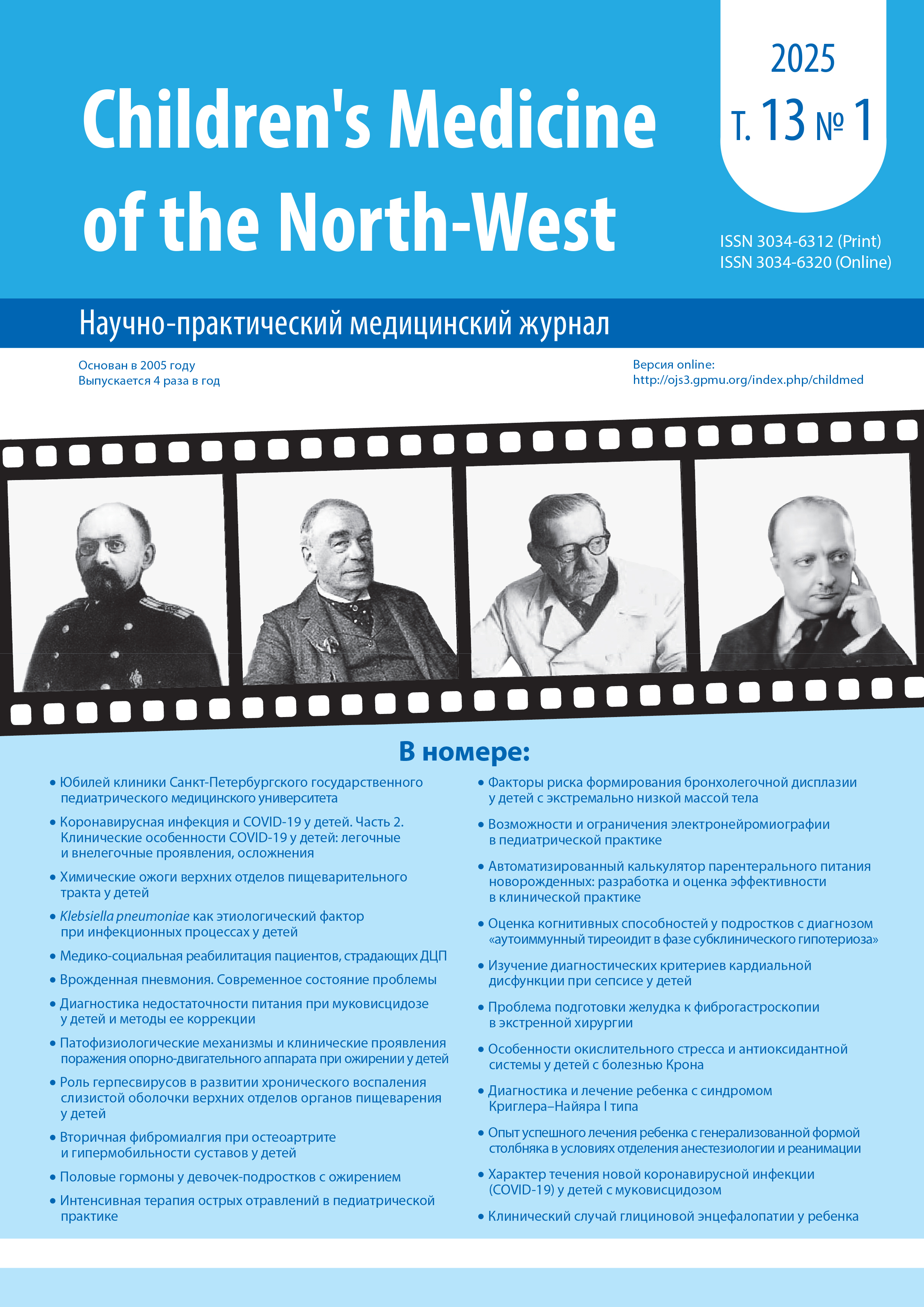ASSESSMENT OF COGNITIVE ABILITIES IN ADOLESCENTS DIAGNOSED WITH “AUTOIMMUNE THYROIDITIS IN THE PHASE OF SUBCLINICAL HYPOTHYROIDISM”
Abstract
Introduction. Thyroid pathology in the structure of endocrine diseases in children occupies one of the leading positions, among them a special place belongs to autoimmune thyroiditis. In adolescence, there is a natural increase in the registration of this pathology, which may cause the development of hypothyroidism. The adolescent is continuously connected with learning, his cognitive abilities should be at a high level, however, neuropsychological studies suggest that the patient’s thinking abilities may be reduced due to thyroid hormone deficiency, which is observed in hypothyroidism, but there is little practical data supporting this hypothesis. Purpose — to evaluate cognitive abilities in adolescents diagnosed with autoimmune thyroiditis in the phase of subclinical hypothyroidism. Materials and methods. On the basis of St. Petersburg children’s city clinic N 35 outpatient department N 47 of St. Petersburg, 60 adolescents 15–17 years old, where 50 patients were the main group and 10 were the control group, were tested within the framework of outpatient admission. Children of the main group had a confirmed diagnosis of “autoimmune thyroiditis in the stage of subclinical hypothyroidism” and took replacement therapy for at least 3 months; the control group had no diseases. To assess cognitive abilities, the following methods were used: Luria test for memory analysis, Raven’s matrices and Schulte tests for attention analysis. The obtained data were statistically processed using the program Microsoft Office Excel 2019 and STATISTIC version 13.3.0 program, using the nonparametric Mann–Whitney U-criterion. The level of significance was taken as p ≤0.05. Results. According to the results, children with autoimmune thyroiditis performed slightly worse on the tasks, especially on tests to analyze attention and long-term memory. Conclusions. The existing cognitive dysfunction is expressed in the fact that it is more difficult for children to cope with tasks that require increased concentration of attention and its rapid switching. This should be taken into account when organizing the educational process of children with autoimmune thyroiditis.
References
Rosalind S. Brown. Autoimmune Thyroiditis in Childhood. J Clin Res Pediatr En docrinol. 2013;5(1):45–49.
Кияев А.В. Аутоиммунный тиреоидит у детей. Попробуем взглянуть по-иному? Клиническая и экспериментальная тиреоидология. 2008;4(3):23–27. DOI: 10.14341/ket20084323-27.
Тимшин А.Р., Цеунов К.С. Определение способностей и их места в структуре когнитивного развития. Вестник науки. 2022;12(57):337–341.
Salerno M., Improda N., Capalbo D. Management of endocrine disease. Subclinical hypothyroidism in children. European Journal of Endocrinology. 2020;183(2):R13–R28. DOI: 10.1530/EJE-20-0051.
Синнаи Г. ред; пер. с англ. под ред. В.А. Петерковой. Детская тиреоидология. М.: ГЭОТАР-Медиа; 2016.
Gencan G., Acar B.C. Autoimmune diseases accompanying hashimoto thyroiditis in pediatric patients. КЭТ. 2022;1.
Трошина Е.А. Хронический аутоиммунный тиреоидит — «сигнальное заболевание» в составе мультиорганного аутоиммунного синдрома. Проблемы эндокринологии. 2023;69(4):4–10. DOI: 10.14341/probl13361.
Мухамбетова Г.А., Варзина Т.В., Илиев Р.Т., Абай Г.А., Кабланбекова Н.А., Новоселова Е., Кореген Г.Т., Кемелбекова М., Халилов Ж. Комплексная диагностика и коррекция когнитивных функций у детей со спастической диплегией. Вестник КазНМУ. 2021;
:320–325.
Золотарева Л.С., Запуниди А.А., Адлер А.В., Степаненко С.М., Папонов О.Н. Диагностика послеоперационной когнитивной дисфункции у детей. ВСП. 2021;20(1):23–30. DOI: 10.15690/vsp.v20i1.2233.
Архипова М.И., Симонова Н.В., Браш Н.Г., Шпинёв А.В. Результаты оценки концентрации внимания и сенсомоторных реакций у пациентов с черепно-мозговой травмой легкой и средней степени тяжести в анамнезе. КВТиП. 2022;21(S2):3–190.
Дамулин И.В., Оразмурадов Г.О. Неврологические нарушения при гипотиреозe. Журнал неврологии и психиатрии им. С.С. Корсакова. 2011;111(3):82–86.



